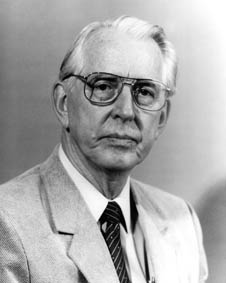James C. Fletcher
James Chipman Fletcher was a two-time NASA administrator and university president. He is a member of The Church of Jesus Christ of Latter-day Saints.
Fletcher was born on June 5, 1919, in Millburn, New Jersey to Lorena Chipman and Harvey Fletcher. His father encouraged his scientific mind. As an adolescent, he accidentally blew a hole in the basement floor. At age fourteen, he built a small working radio.
After graduating from high school in New York City, he studied at Brigham Young University for two years and then earned a bachelor’s degree in physics from Columbia University in 1940. He went on to earn a PhD in physics from the California Institute of Technology in 1948. At the beginning of World War II, he worked on defense projects for the U.S. navy Bureau of Ordnance. He did classified defense work at Harvard University’s Cruft Laboratory and then in 1942 he became a research physicist and instructor at Princeton University until the end of the war. At Princeton, he was influenced by his father’s friend, Henry Eyring, who helped his testimony of the gospel of Jesus Christ grow.
In 1948 he became the 120th person to work for Hughes Aircraft. His division grew to more than 23,000 employees in the six years he worked for Hughes. He then worked at the Guided Missile Division of the Ramo-Wooldridge Corporation. He helped design its first intermediate-range missile, the Thor, and its first intercontinental missile, the Atlas. He supervised the electronics and guidance work on the follow-up Intercontinental Ballistic Missile, the Titan, and was program manager for development of the Minuteman missile, which makes up most of the United States’ present nuclear force. In 1958 he co-founded the Space Electronics Corporation of Glendale, California, which later merged and became the Space General Corporation. He sold his share in 1960 to avoid a pursuit of money. Later he became the systems vice president of the Aerojet General Corporation in Sacramento, California.
At the beginning of the 1960s, as the United States and Russia were developing their nuclear capacities, Fletcher was part of a panel of scientists who visited cities in the United States to discuss prospects of a nuclear holocaust. He said the comments of one man in the audience influenced his role in working for national defense. The man said:
- Well, now, you fellows sound pretty awful. The end of the world is so soon! But you’re making an assumption I don’t accept. You’re assuming that there’s no way you can sit down with the Russians and talk about this. As far as I can tell, all the Russians I’ve met are pretty nice people. And they think of their country the same way you fellows think of your country. You ought to be able to gradually get them to come around toward your way of thinking and you come around to theirs. And when you do that, there won’t be any need for mutual assured destruction.
The man was Fletcher’s father.[1] Fletcher became a consultant to the U.S. Arms Control and Disarmament Agency in 1961. He was part of the group of scientist who worked to resolve differences between the countries.
He is the only person to serve twice as National Aeronautics and Space Administration (NASA) administrator, first from April 1971 to May 1977, and second from May 1986 to April 1989. He was well respected for his work to build the U.S. space program. During his administration, the last three Apollo missions went to the moon, the Space Shuttle effort began, and the Viking program sent landers to Mars. He oversaw the Skylab missions, began the Voyager space probes, and sent the Pioneer 10 spacecraft on a 21-month mission to inspect Jupiter. In this time period, the Russians and Americans joined in the 1975 Apollo-Soyuz manned space venture. He also oversaw the efforts of NASA to recover from the Space Shuttle Challenger’s accident and the Space Shuttle’s return to flight in September 1988. He also approved the Hubble Space Telescope program.
From May 1977 to May 1986, he accepted a professorship at the University of Pittsburgh. He held an endowed chair and served on numerous boards and committees. He was also an independent consultant through his company, James C. Fletcher & Associates, and served on an advisory board that developed the Strategic Defense Initiative.
In 1964, Fletcher became president of the University of Utah, where he remained for seven years. While there, he expanded the Institute for Biomedical Engineering, which included the Artificial Organs Division. In 1982, U of U doctor William DeVries successfully implanted the first artificial heart in a human, Barney Clark.
Fletcher married Fay Lee in 1946. They had four children. He died of lung cancer on December 22, 1991.
